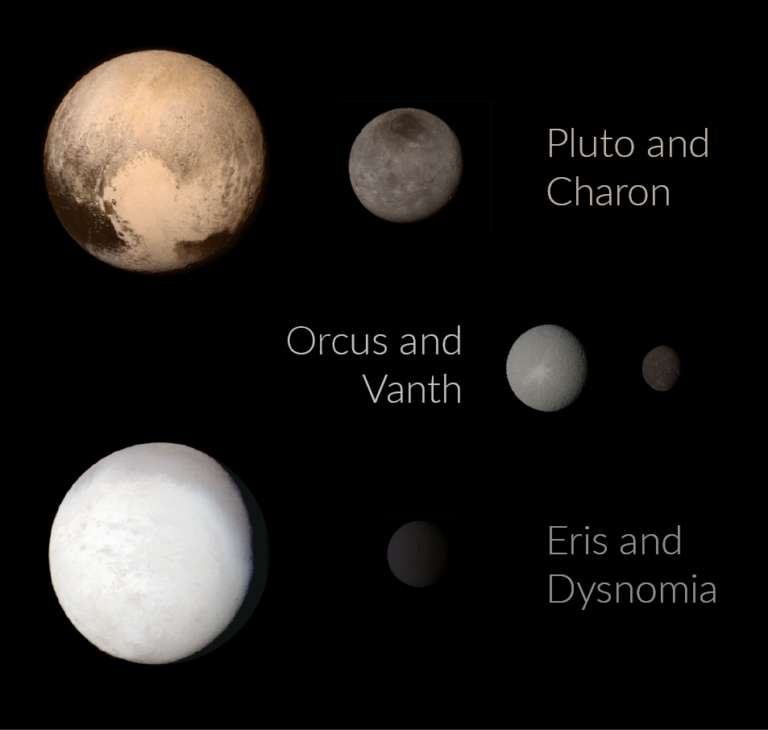Emily Lakdawalla • Jan 25, 2018
Some big moons in the Kuiper belt
The Kuiper belt is full of weirdness. In the "inner" solar system -- by which, for the purposes of this post, I mean everything inside Neptune's orbit -- there are lots of round moons, but they're all quite a bit smaller than their primary planets. Relative to its primary, the biggest moon is our own Moon, which has a quarter the diameter of Earth and about one percent of Earth's mass. Out in the Kuiper belt, though, relatively large satellites are common; there are several round worlds that, despite being quite a bit smaller than our own Moon, have moons that are also big enough to be round. In a new preprint, Mike Brown and Bryan Butler show evidence that two of those moons are even bigger than we used to think.
For context, consider the Pluto system. Charon is huge relative to Pluto -- half of Pluto's diameter, and one eighth of Pluto's mass. They're similar enough in size that the two clearly mutually orbit a point that is located outside either of them:

The new paper concerns moons of two other large worlds: Eris and Orcus. Eris is similar in size to Pluto; Orcus is smaller than Charon but still somewhere around the eighth biggest object that we know of in the Kuiper belt. Each has a moon: Eris has Dysnomia, while Orcus has Vanth. Brown and Butler used the ALMA interferometric radio telescope array to resolve the moons as separate objects from the primaries and measure their diameters from the thermal energy their cold surfaces radiate at millimeter wavelengths. Here's a summary of the results, compared to Pluto/Charon.
Object | Diameter | Albedo | Semimajor axis |
|---|---|---|---|
Pluto | 2374 km | 0.52 |
|
Pluto's moon Charon | 1212 km | 0.38 | 19,596 km |
Eris | 2326 +/- 12 km | 0.99 |
|
Eris' moon Dysnomia | 700 +/- 115 km | 0.04 +0.02/-0.01 | 37,460 km |
Orcus | 910 +50/-40 km | 0.23 +/- 0.02 |
|
Orcus' moon Vanth | 475 +/- 75 km | 0.08 +/- 0.02 | 9,006 km |
The new number for Vanth is larger than previously estimated, and the new number for Dysnomia is much larger. Dysnomia's reported diameter is really very big, big enough to make it somewhere around 20th-largest known object in the Kuiper belt.
Let's put all these together on a graphic comparing their relative sizes. Like I often do, I'm using moons of Saturn, Uranus, and Neptune to stand in for Eris, Dysnomia, Orcus, and Vanth, for which we have no resolved photographs. I've taken worlds that we've visited and resized them proportionately, and I've also adjusted the contrast in the images to try to give a sense of the relative brightnesses. The brightness comparison is not precise -- it's just meant to give a feel for the differences among these worlds. That's hard to do well, though, because Dysnomia is (according to the Brown and Butler study) bizarrely darker-than-coal black next to Eris' whiter-than-snow brightness.

As for Orcus and Vanth, they're pretty ordinary-looking for Kuiper belt worlds of their sizes. What's especially fun about that pair is that if you scaled up the Orcus system so that Orcus matched the size of Pluto, then Vanth would pretty closely match the size of Charon, and the separation between the two would scale properly, too. Orcus and Vanth presents a pint-sized version of the Pluto-Charon system.
Support our core enterprises
Your support powers our mission to explore worlds, find life, and defend Earth. You make all the difference when you make a gift. Give today!
Donate

 Explore Worlds
Explore Worlds Find Life
Find Life Defend Earth
Defend Earth

